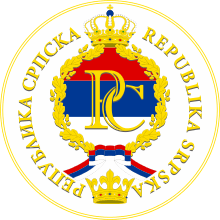Municipalities of Republika Srpska

Under the "Law on Territorial Organization and Local Self-Government" adopted in 1994, Republika Srpska was divided into 80 municipalities. After the conclusion of the Dayton Peace Agreement, the law was amended in 1996 to reflect the changes to the entity's borders and now provides for the division of Republika Srpska into 64 municipalities.
List of municipalities
 |
| This article is part of a series on the politics and government of Republika Srpska |
|
Constitution |
|
Executive |
|
Legislature
|
|
Judiciary |
|
Elections and referendums |
|
Divisions |
|
Foreign relations |
|
The following are the 64 municipalities of Republika Srpska:
- Banja Luka (City status)
- Berkovići
- Bijeljina (City status)
- Bileća
- Bratunac
- Brod
- Čajniče
- Čelinac
- Derventa
- Doboj (City status)
- Donji Žabar
- Foča
- Gacko
- Gradiška
- Han Pijesak
- Istočna Ilidža
- Istočni Drvar
- Istočni Mostar
- Istočno Novo Sarajevo
- Istočni Stari Grad
- Istočno Sarajevo (City status)
- Jezero
- Kalinovik
- Kneževo
- Kostajnica
- Kotor Varoš
- Kozarska Dubica
- Krupa na Uni
- Kupres
- Laktaši
- Lopare
- Ljubinje
- Milići
- Modriča
- Mrkonjić Grad
- Nevesinje
- Novi Grad
- Novo Goražde
- Osmaci
- Oštra Luka
- Pale
- Pelagićevo
- Petrovac
- Petrovo
- Prijedor (City status)
- Prnjavor
- Ribnik
- Rogatica
- Rudo
- Sokolac
- Srbac
- Srebrenica
- Stanari
- Šamac
- Šekovići
- Šipovo
- Teslić
- Trebinje (City status)
- Trnovo
- Ugljevik
- Višegrad
- Vlasenica
- Vukosavlje
- Zvornik (City status)
Renamed municipalities
On February 27, 2004, the Constitutional Court of Bosnia and Herzegovina issued an opinion declaring the names of certain municipalities in Republika Srpska to be in violation of the Constitution of Bosnia and Herzegovina for the reason that the war names "are not consistent with the constitutional principle of the equality of the constituent peoples in Bosnia and Herzegovina.[1]" Afterwards, the parliament of Republika Srpska accepted new names for the municipalities.[2] On September 22, 2004, the Court decided that the former names "be temporary replaced" with new names.[3] The following are the former and new names of the affected municipalities:
| Old names | Proposed by Constitutional Court | Proposed by parliament |
|---|---|---|
| Srpski Drvar | Istočni Drvar | Istočni Drvar |
| Srpski Sanski Most | Oštra Luka | Oštra Luka |
| Srpski Mostar | Istočni Mostar | Istočni Mostar |
| Srpsko Goražde | Ustiprača | Novo Goražde |
| Srbinje | Foča | Foča |
| Srpski Ključ | Ribnik | Ribnik |
| Srpska Kostajnica | Bosanska Kostajnica | Kostajnica |
| Srpski Brod | Bosanski Brod | Brod |
| Srpska Ilidža | Kasindo | Istočna Ilidža |
| Srpsko Novo Sarajevo | Lukavica | Istočno Novo Sarajevo |
| Srpski Stari Grad | Istočni Stari Grad | Istočni Stari Grad |
| Srpsko Orašje | Donji Žabar | Donji Žabar |
Former municipalities
The Law on Territorial Organization and Local Self-Government was amended in 1996 to provide that certain municipalities whose territory was now completely or partially located in the Federation of Bosnia and Herzegovina would "temporarily stop functioning." In addition, the parts of these former municipalities that were located in Republika Srpska (if any) were incorporated into other municipalities.
The following are the former municipalities of Republika Srpska:
- Glamoč (part included in Šipovo)
- Gradačac (parts included in Modriča and Pelagićevo)
- Grahovo (formerly Bosansko Grahovo)
- Hadžići
- Ilijaš (part included in Sokolac)
- Konjic (parts included in Nevesinje)
- Kladanj (parts included in Šekovići)
- Lukavac (parts included in Petrovo)
- Maglaj (parts included in Doboj)
- Olovo (parts included in Sokolac)
- Skelani (included in Srebrenica)
- Srbobran (parts included in Šipovo) (formerly Donji Vakuf)
- Tuzla (parts included in Lopare)
- Vogošća
Sarajevo
In 1993, the Law on the Serb City of Sarajevo during the State of War or Immediate Danger of War[4] was adopted providing that Serb Sarajevo (later Istočno Sarajevo) consisted of the following municipalities: Centar, Hadžići, Ilidža, Ilijaš, Novo Sarajevo, Stari Grad, Rajlovac, Vogošća, and Trnovo. Centar, Hadžići, Ilijaš, Rajlovac, and Vogošća were incorporated into the Federation of Bosnia and Herzegovina. The city now consists of the following six municipalities: Srpska Ilidža (name replaced by "Kasindo" in 2004), Srpsko Novo Sarajevo (name replaced by "Lukavica" in 2004), Pale, Sokolac, Srpski Stari Grad (name replaced by "Istočni Stari Grad" in 2004), and Trnovo.
In 1996, the name "Serb City of Sarajevo" was changed to "City of Srpsko Sarajevo". In 2004, the Constitutional Court of Bosnia and Herzegovina decided that the temporary name of the city would be decided that the former name of the city "be temporary replaced" with the name "City of Istočno (East) Sarajevo".
Brčko
A significant portion of the Brčko District (48% of its area) was created from territory of Republika Srpska (RS). RS controlled this territory until March 8, 2000 (see the History and Mandate of the OHR North/Brcko). The Brčko District was created as a shared territory, a a condominium, of both entities (RS and the Federation of Bosnia and Herzegovina), but it was not placed under control of either, and is hence under direct jurisdiction of Bosnia and Herzegovina. RS's authorities never officially accepted the Brčko Arbitration result, but nevertheless had to comply.
See also
- List of cities in Bosnia and Herzegovina
- List of settlements in Bosnia and Herzegovina
- Municipalities of Bosnia and Herzegovina
References
- ↑ 044-01 Decision English.ZIP U 044-01
- ↑ Paljanske novine, #17: На гласачким листићима стари називи за 13 општина у РС
- ↑ U 44-01
- ↑ The Law on the Serb City of Sarajevo during the State of War or Immediate Danger of War (Official Gazette of the Republika Srpska, No. 25/93)